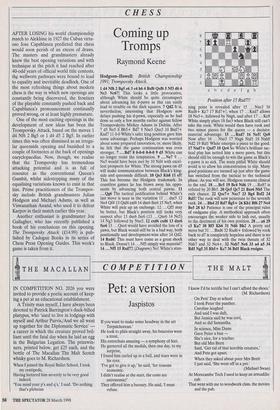CHESS
Coming up Tromps
Raymond Keene
lER LOSING his world championship match to Alekhine in 1927 the Cuban virtu- oso Jose Capablanca predicted that chess would soon perish of an excess of draws. The masters and grandmasters already knew the best opening variations and with technique at the pitch it had reached after 40-odd years of official world title contests, th.p wellwom pathways were bound to lead to equality and inevitable deadlock. One of the most refreshing things about modern chess is the way in which new openings are constantly being discovered, the frontiers of the playable constantly pushed back and Capablanca's pronouncement continually proved wrong, or at least highly premature.
One of the most exciting openings in the development of new ideas has been the Trompovsky Attack, based on the moves 1 d4 Nf6 2 Bg5 or 1 d4 d5 2 Bg5. In earlier times this was often dismissed as an irregu- lar queenside opening and banished to a couple of footnotes at the back of openings encyclopaedias. Now, though, we realise that the Trompovsky has tremendous attacking potential and is as full of resource as the conventional Queen's Gambit, whilst sidestepping many of the equalising variations known to exist in that line. Prime practitioners of the Trompov- sky include British grandmasters Julian Hodgson and Michael Adams, as well as Viswanathan Anand, who used it to defeat Karpov in their match earlier this year.
Another enthusiast is grandmaster Joe Gallagher, who has recently published a book of his conclusions on this opening. The Trompovsky Attack (£14.99) is pub- lished by Cadogan Books in its series of Chess Press Opening Guides. This week's game is taken from it. Hodgson–Howell: British Championship 1991; Trompovsky Attack.
1 d4 Nf6 2 Bg5 e6 3 e4 h6 4 Bxf6 Qxf6 5 Nf3 d6 6 Nc3 Nc6?! This looks a little provocative, although White should be quite circumspect about advancing his d-pawn as this can easily lead to trouble on the dark squares. 7 Qd2 It is, nevertheless, interesting that Hodgson now delays pushing his d-pawn, especially as he had done so only a few months earlier against fellow Trompovskyite Mickey Adams in Dublin. After 7 d5 Ne5 8 Bb5+ Bd7 9 Nxe5 Qxe5 10 Bxd7+ Kxd7 110-0 White's safer king position gave him some advantage. Perhaps Hodgson was worried about some prepared innovation, or, more likely, he felt that the game continuation was even stronger. 7 ...Bd7 8 0-0-0 0-0-0 9 d5 White can no longer resist the temptation. 9 ... Ne7 9 ... Ne5 would have been met by 10 Nd4 with excel- lent prospects for White. The strong pawn on d5 will make communication between Black's king- side and queenside difficult. 10 Qe3 Kb8 11 e5! This has become the Hodgson trademark. In countless games he has blown away his oppo- nents by advancing both central pawns. 11 Qg6 The tactical justification behind White's last move is seen in the variation 11 ... dxe5 12 Ne4 Qf4 13 Qxf4 exf4 14 dxe6 fxe6 15 Ne5, when White will pick up an exchange. 12 ... Q15 may be better, but Black's position still looks very suspect after 13 dxe6 fxe6 (13 ... Qxe6 14 Nc5) 14 Ng3 followed by Nxe5. 12 exd6 cxd6 13 dxe6 fxe6 13 ...Qxe6 would have avoided the loss of a pawn, but Black would still be in a bad way, both positionally and development-wise after 14 Qd2. 14 Rxd6! This must have come as a great shock to Black. Doesn't 14 ... Nf5 simply win material? 14 ... Nf5 15 Rxd7!! (Diagram) No! White's stun- Position after 15 Rxd7!!
ning point is revealed after 15 Nxe3 16 Rxd8+ Kc7 17 Rd7+!, when 17 ... Kxd7 allows 18 Ne5+ , followed by Nxg6, and after 17 ... Kc8 White simply plays 18 fixe3 when Black still can't take the rook. White would then have rook and two minor pieces for the queen — a decisive material advantage. 15 ...Rxd7 16 Ne5! Qe8 Now after 16 ... Nxe3 17 Nxg6 Nxf1 18 Nxh8 Nd2 19 Rdl White emerges a piece to the good. 17 Nxd7+ Qxd7 18 Qe4 So White's brilliant tac- tical play has netted him a mere pawn, but this should still be enough to win the game as Black's e-pawn is so sick. The main pitfall White should avoid is to allow his concentration to slip. Many good positions are messed up just after the game has switched from the tactical to the technical phase. As you will see, Hodgson remains clinical to the end. 18 ...Bc5 19 Bc4 Nd6 19 ... Re8? is refuted by 20 Bb5. 20 Qe5 Qc7 21 Bxe6 Nb5 The only chance. 22 Qxc7+ Nxc7 23 Bg4 Bxf2 24 Rdl! The rook will now penetrate to the seventh rank. 24 ...Bh4 25 Rd7 BgS+ 26 Kbl Bf6 27 Ne4 Be5 28 h3 Patience is one of the principal rules of endgame play. A methodical approach often encourages the weaker side to lash out, usually to the detriment of his own position. 28 ...a6 29 c3 Ka7 30 Bf3 Kb6 31 Nd6 Bh2 A pretty sad move but 31 ... Bxd6 32 Rxd6+ followed by rook back to d7 is completely hopeless and there is no other way to deal with the twin threats of 32 Nxb7 and 32 Nc4+. 32 Nxb7 Ne6 33 a4 a5 34 Rd5 Ng5 35 Rb5+ Kc7 36 Bd5 Black resigns.






















































 Previous page
Previous page